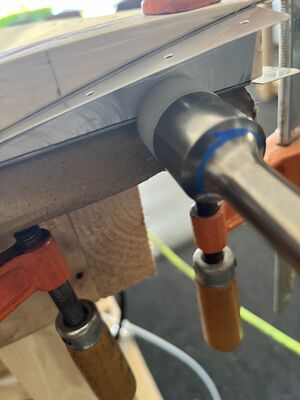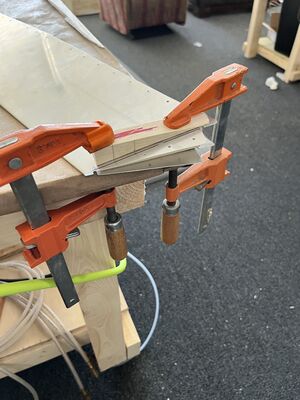SECTION 9: ELEVATORS: Difference between revisions
m (→Page 9-7) |
No edit summary |
||
| Line 10: | Line 10: | ||
==== Page 9-7 ==== | ==== Page 9-7 ==== | ||
* Step 4: Some builders prefer CNC machined cable anchor brackets (WD-415) over the welded ones that come with the kit (Vans did have issues with the first version of them since they only had a weld on one side of the nut). Do your research before ordering a set from iflyrv10.com. See [https://www.facebook.com/groups/vansrv10/posts/7196160973838273 this FB post].<br>Consider using fasteners instead of rivets to attach WD-415. If they are riveted, you need to rotate the entire access cover to adjust the length. It's possible, but it takes to move the F-1095A trim mount bracket all the way aft to have enough cable sticking out. | * Step 4: Some builders prefer CNC machined cable anchor brackets (WD-415) over the welded ones that come with the kit (Vans did have issues with the first version of them since they only had a weld on one side of the nut). Do your research before ordering a set from iflyrv10.com. See [https://www.facebook.com/groups/vansrv10/posts/7196160973838273 this FB post].<br>Consider using fasteners instead of rivets to attach WD-415. If they are riveted, you need to rotate the entire access cover to adjust the length. It's possible, but it takes to move the F-1095A trim mount bracket all the way aft to have enough cable sticking out. | ||
==== Page 9-15 ==== | |||
* Step 6: You can use solid rivets instead of blind rivets on the bottom skin if you really want to. If you can fit your bucking bar through the lightening hole on the front spar, then you can turn the elevator and set it vertically resting on the tip rib assembly. This lets the bucking bar sit flat and gravity helps hold it in place. You can get your fingers through the lightening hole to hold it while using normal rivets. | |||
* Step 12: do NOT alternate directions of the rivets like you did on the rudder; make sure the factory (flat) head is on the top skin of the elevators. | |||
---- | ---- | ||
Dave Corwith: | Dave Corwith: | ||
| Line 29: | Line 35: | ||
[[File:2022-03-28 16-10-02.jpg|300px]] | [[File:2022-03-28 16-10-02.jpg|300px]] | ||
---- | ---- | ||
'''Section 9-20 Safety Wire''' | |||
* I used 0.32 stainless steel safety wire. | |||
'''Section 9-21 Trim Tab Templates''' | '''Section 9-21 Trim Tab Templates''' | ||
* as svg files, they print correctly 1:1 with e.g. free Inkscape (https://inkscape.org/))<br>[[:Media:Trailing edge foam ribs.svg|Trailing edge foam ribs.svg]]<br>[[:Media:Trim tab foam ribs.svg|Trim tab foam ribs.svg]]<br>See also hints concerning printing at 1:1 scale in [[SECTION_39:_CONTROL_SYSTEM]] | * as svg files, they print correctly 1:1 with e.g. free Inkscape (https://inkscape.org/))<br>[[:Media:Trailing edge foam ribs.svg|Trailing edge foam ribs.svg]]<br>[[:Media:Trim tab foam ribs.svg|Trim tab foam ribs.svg]]<br>See also hints concerning printing at 1:1 scale in [[SECTION_39:_CONTROL_SYSTEM]] | ||
[[Category:Hints]] | [[Category:Hints]] | ||
Revision as of 20:18, 21 April 2024
Build Instruction Updates
- 9/6/2023 09_10.pdf
Skin bonding to rear spar.
Check for more recent updates here
Builder Videos
Plane Lady:
Page 9-7
- Step 4: Some builders prefer CNC machined cable anchor brackets (WD-415) over the welded ones that come with the kit (Vans did have issues with the first version of them since they only had a weld on one side of the nut). Do your research before ordering a set from iflyrv10.com. See this FB post.
Consider using fasteners instead of rivets to attach WD-415. If they are riveted, you need to rotate the entire access cover to adjust the length. It's possible, but it takes to move the F-1095A trim mount bracket all the way aft to have enough cable sticking out.
Page 9-15
- Step 6: You can use solid rivets instead of blind rivets on the bottom skin if you really want to. If you can fit your bucking bar through the lightening hole on the front spar, then you can turn the elevator and set it vertically resting on the tip rib assembly. This lets the bucking bar sit flat and gravity helps hold it in place. You can get your fingers through the lightening hole to hold it while using normal rivets.
- Step 12: do NOT alternate directions of the rivets like you did on the rudder; make sure the factory (flat) head is on the top skin of the elevators.
Dave Corwith:
Section 9-16 Elevator Trim Tab Fabrication:
My Notes:
- Step 5 Bending the ends of the trim tabs:
Make a wooden trim tab template verbatim from the templates. Use this on the inside of the area to be bent. Now put a reverse wedge on the top so the clamps will work. Now the outboard end is square (90 deg) so offset 1/32 as illustrated then clamp to table FIRM, and bend with wood block. I skipped the double sided tape as I was able to precisely clamp w/ 1/32 offset. I used a plastic peen on the rivet gun set to 40 psi. Bend the bottom first. Use the plastic peen to sharpen the edge of the bend. - Now bend the top down and match drill.
When doing the other end, draw a line w/ sharpie from the angle edges. Put the wood block in at the same angle as the line. Clamp to the table same as other end. Clamp it FIRM.
Section 9-17 Step 2:
I used my buddy's 90 deg "shear/brake" with a 1/4-1/2" angle iron. I slightly opened up the trim tab while gently bending to 15 degrees. Came out ok. Better than just doing it with duck bill pliers.
Section 9-20 Safety Wire
- I used 0.32 stainless steel safety wire.
Section 9-21 Trim Tab Templates
- as svg files, they print correctly 1:1 with e.g. free Inkscape (https://inkscape.org/))
Trailing edge foam ribs.svg
Trim tab foam ribs.svg
See also hints concerning printing at 1:1 scale in SECTION_39:_CONTROL_SYSTEM

